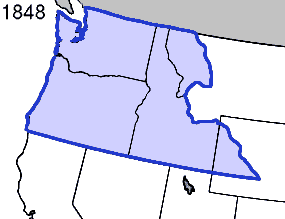Why Is it Named Idaho? Idunno!


Most places get names from, well, somewhere. Let’s just focus on some U.S. states, to make it easy. Connecticut gets its name from an Algonquian word, transliterated, which means “long tidal river,” a reference to the river which runs through it from north to south. Nevada comes from the Spanish word “nevada” which means “snowfall” because the Sierra Nevada mountains are often snow-covered. Delaware is named for an early governor of the then-colony of Virginia, Sir Thomas West, 3rd Baron De La Warr. (They could have just called it “West’s Virginia,” but that would have been ultimately incredibly confusing.)
Idaho? That’s a mystery. And the most popular explanation is just plain embarrassing.
If you looked at a map of the United States in 1848, the state we now call Idaho was part of Oregon Territory at the time, as seen above. The area’s borders shifted a lot over the years, first in 1853 (here’s another map) and then again in 1859 (and another map) when Oregon became a state in 1859. When it became clear that Washington was likely to become a state — now were’ in 1863 — the map shifted again, creating a heretofore unnamed territory. (Here’s another map.)
That territory needed a name and Congress went with “Idaho Territory,” borrowing a term that had popped up in the region previous. A Congressional record from 1860 first used the word “Idaho” although without much context. Nevertheless, it fell into use, first, for a steamship in the area and then Idaho Springs, Colorado (1861). Congress used it for Idaho Territory (1863), and then it spread to various other places. But where did it come from in the first place? The Congressional record is silent as to the etymology of the term, but everyone assumed that it was derived from a Native American term. The region pictured above was settled by Americans only a few decades prior; Native Americans, on the other hand, had lived there for centuries.
The proof wouldn’t come for a while though, and when it finally did, it was both unreliable and unwanted. In 1875 — yes, a dozen years after Idaho Territory became Idaho Territory — a former aide to Abraham Lincoln named William Stoddard wrote an article about the name for the New York Daily Tribune. According to him, the culprit was George M. Willings, a lobbyist with a penchant for leveraging his relationships in Congress to further eccentricities. Willings, per Stoddard, convinced Congress to name the territory after the Shoshone word for “gem of the mountains,” or, “Idaho.” (The Shoshone are a Native American tribe from the area.) And Congress agreed. Ultimately, the new state became “Idaho” in 1890 and later adopted the nickname “The Gem State.”
There was only one problem: per the same account, Willings made the name up. “Idaho” doesn’t come from anywhere other than his imagination, and it doesn’t mean anything.
While it’s unclear Stoddard’s account is true — Willings had a reputation for being a self-promoter, even at the expense of the truth — there isn’t another credible etymology for Idaho’s name. At best, it’s been lost to history; at worst, it’s the result of a political prankster’s impressive hoax.
Bonus fact: OreIda-brand french fries and tater tots get their name from the region discussed above — “Oregon” and “Idaho” — as the potatoes in their products come from the region. (Their old logo made that clear.)
From the Archives: Why It May Be Okay to Drop Beavers from Airplanes: A story about Idaho.
